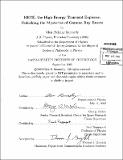HETE, the High Energy Transient Explorer : unlocking the mysteries of gamma ray bursts
Author(s)
Monnelly, Glen Pickslay, 1973-
DownloadFull printable version (6.283Mb)
Alternative title
High Energy Transient Explorer
Other Contributors
Massachusetts Institute of Technology. Dept. of Physics.
Advisor
George Ricker and Saul Rappaport.
Terms of use
Metadata
Show full item recordAbstract
The High Energy Transient Explorer (HETE), was built primarily at MIT and launched in October 2000 with the goal of studying Gamma Ray Bursts (GRBs) at X-ray and gamma-ray energies. A suite of instruments aboard HETE provide broadband sensitivity to GRBs: the French Gamma Telescope (FREGATE; 6 keV to > 400 keV ) instrument provides sensitive detections at gamma-ray energies, the Wide-Field X-Ray Monitor (WXM; 2 to 28 keV) provides detection and localization (5-10' radius) at X-ray energies, and the Soft X-ray Camera (SXC; 1.3 to 14 keV) provides refined localization (< 1' radius) capabiities at soft X-ray energies. GRB positions, determined in-flight, are promptly transmitted to the ground via the Burst Alert Network (BAN), and disseminated to interested observers for X-ray, optical, and radio follow-up observations. The HETE Operations center is located at MIT. This dissertation provides an overview of HETE with a particular focus on the building, testing, and performance of the SXC. To date the WXM has localized 18 GRBs, which have among them a number of interesting properties. Six are X-ray rich, which are of particular interest because they are not as well studied as classical GRBs. Beginning with the discovery of an optical transient at z = 0.45 for GRB 010921, five WXM GRB localizations have led to the identification of an afterglow transient (GRB 010921, GRB 020124, GRB 020305, and GRB 020331 in optical; GRB 020127 in radio). Optical follow-up observations with the Magellan 6.5m Baade Telescope of GRB 011130, GRB 011212, and GRB 020331 are described, including the discovery of the host galaxy of GRB 020331. X-ray observations of GRB 011130 with the Chandra X-ray Observatory at two different epochs have not conclusively revealed an X-ray counterpart among 61 detected X-ray point sources.
Description
Thesis (Ph. D.)--Massachusetts Institute of Technology, Dept. of Physics, 2002. Includes bibliographical references (p. 135-157).
Date issued
2002Department
Massachusetts Institute of Technology. Department of PhysicsPublisher
Massachusetts Institute of Technology
Keywords
Physics.